Anethum graveolens
The smell of dill takes me straight to my happy place: Mediterranean-style meals, warm spring days, and soft feathery plants.
Life doesn’t get much better than that does it?
Luckily, those of us who love this aromatic herb don’t have to rely on the market for a fresh supply, as we can easily grow our own.
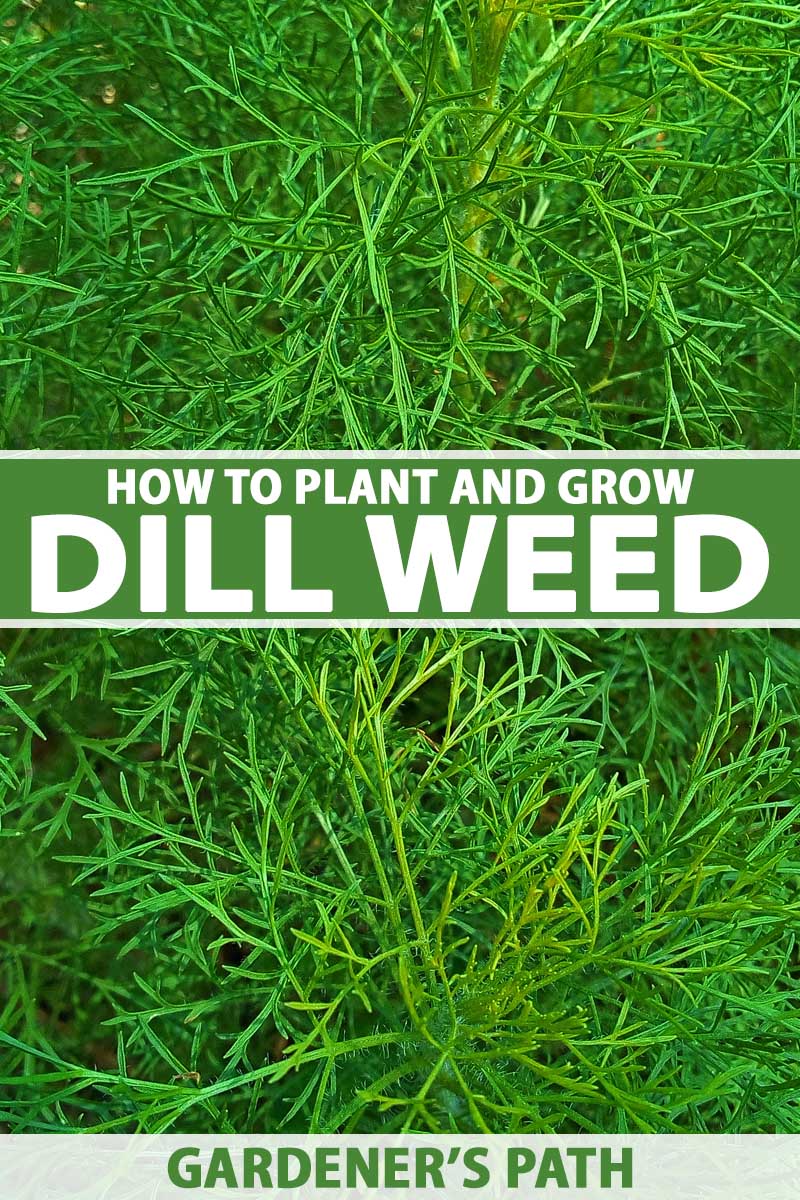
We link to vendors to help you find relevant products. If you buy from one of our links, we may earn a commission.
I’ll take you through every step in the process of growing this wonderfully ornamental and tasty plant.
And so you know what lies ahead, here’s what I’ll cover:
What You’ll Learn
Cultivation and History
If dill makes you think of tasty Mediterranean dishes like it does for me, there’s a reason for that.
While its exact origin is not entirely certain, this herb is likely native to the Mediterranean region and western Asia – places where it is widely used in the local cuisine.
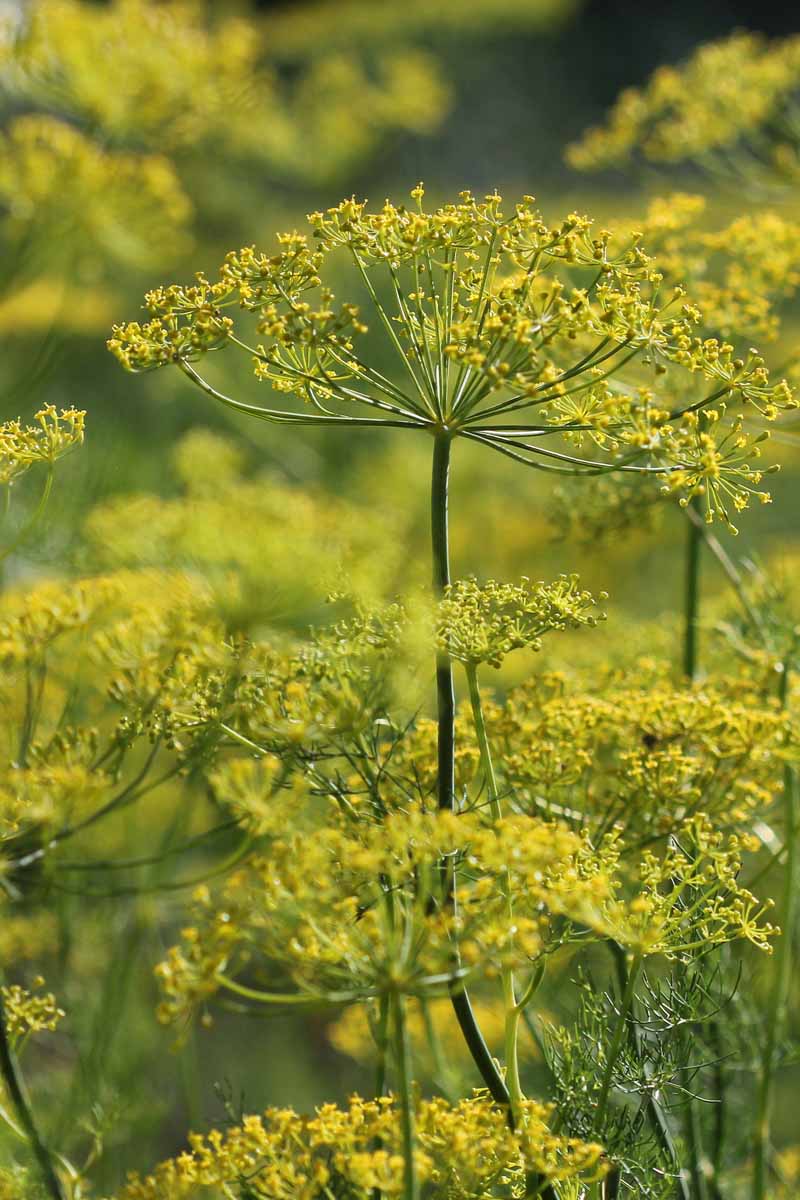
These days, it easily naturalizes in other locations with Mediterranean-type climates, such as California.
But it also escapes cultivation and grows like a weed in places with decidedly non-Mediterranean climates, such as the northeastern US.
Growing to a mature height of three to four feet tall on average, this annual plant has branching, hollow stems graced with soft, fern-like leaves.
These feathery leaves are a cool toned, bluish-green hue.
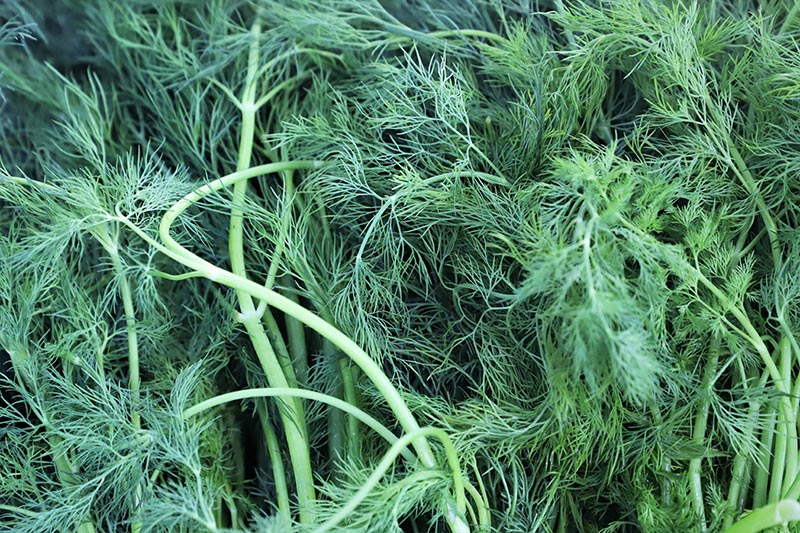
This herb holds its tiny yellow flowers up in a flattened cluster called an umbel, which is about six inches wide.
Although dill looks a lot like fennel, these two aromatic plants are in the same family, but are not as closely related as you might think.
In addition to fennel, dill has many other tasty and fragrant relatives, including caraway, parsley, anise, and cilantro.
These herbs and spices are all members of the Umbellifer (Apiaceae) family, so called because of their umbrella-shaped flower heads.
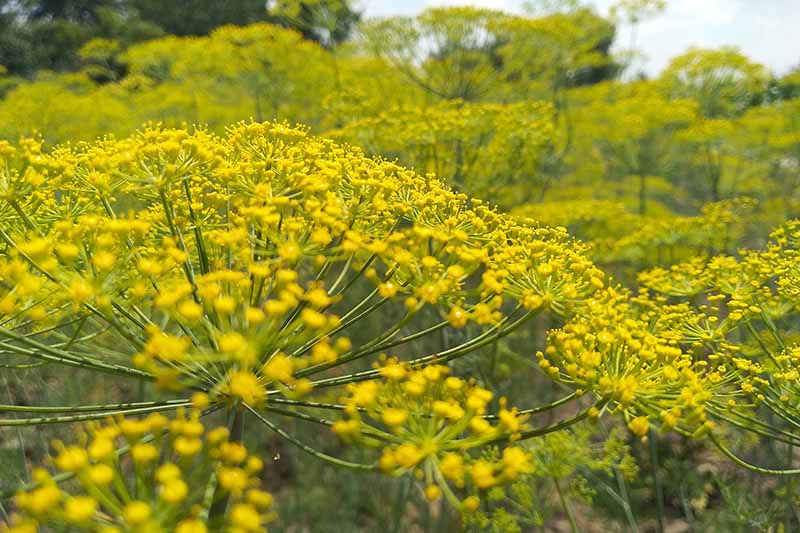
Dill’s genus name Anethum comes from the Greek word for this plant, which means “strong smelling.”
The English name refers not to its smell, but to its medicinal use.
The word “dill” is thought to have Norse origins, coming from a word that meant to lull or to soothe, referring to its reputation as a stomach soother.
But dill goes back even further in time than the Vikings, having been used as food and medicine for thousands of years.
The name anethum is mentioned in the Bible, and it was used as a flavoring in ancient Egypt, tracing its culinary use at least as far back as 5,000 years ago.
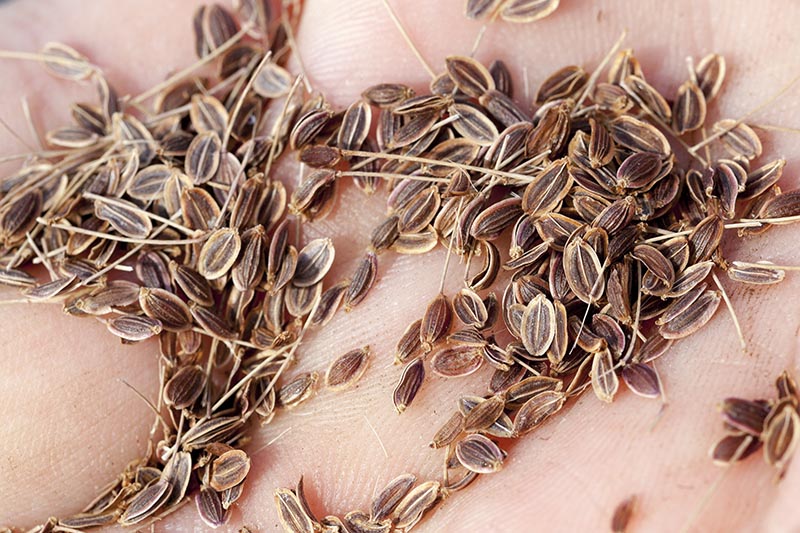
Like its cousin cilantro, both the foliage and the seeds of this plant are used culinarily.
The leaves are used as an herb referred to as dill weed, distinguishing it from its dried fruits, which you’ll find on spice racks labeled as dill seed.
Essential oils are extracted from both the seeds and the leaves, and are used by herbalists for medicinal purposes.
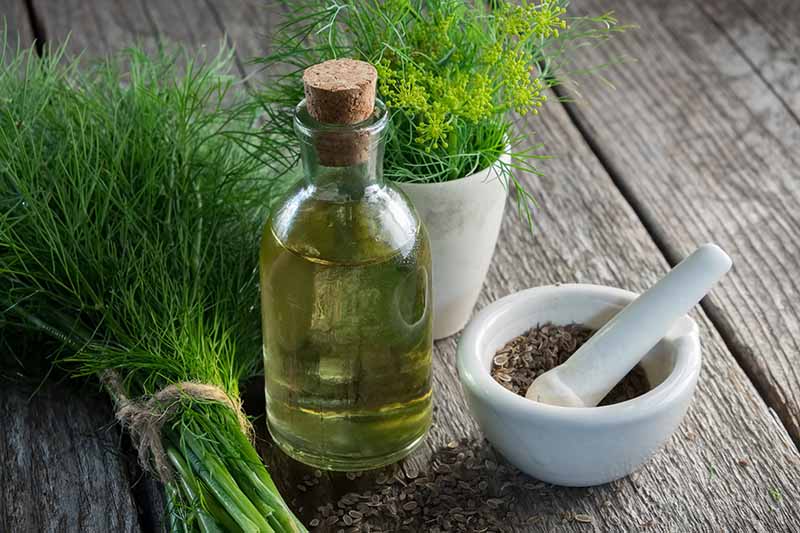
Remember the soothing origins of the English word for this plant?
Its medicinal use has been widespread, to treat gastrointestinal issues in Asian, European, and Native American traditional medicine, and the medicinal properties of various parts of this plant are still being studied today.
Modern research backs up its traditional use as a carminative, to reduce or prevent flatulence.
The essential oil from this herb has antimicrobial, antifungal, and antioxidant properties, and it is even used to help preserve food in industrial food manufacturing.
In addition to culinary and medicinal uses, this plant also has a well-deserved place in ornamental gardens.
Its feathery foliage provides a soft backdrop for garden plants with contrasting textures, and its bright yellow flower heads add a wispy layer of color – both of which are useful in designing one’s own charming little cottage garden.
Dill Plant Propagation
With all those wonderful uses, you’re probably ready to start your own patch of homegrown dill!
There are a couple of things you should know before you get started.
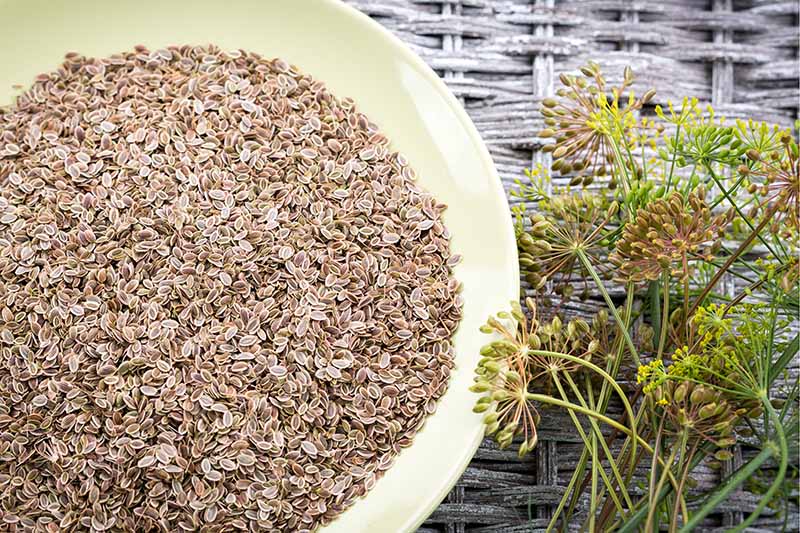
The first is that it is a cool season herb that is hardy to 25°F, and can be grown in USDA Hardiness Zones 2 to 11.
That means it is accessible to most of us North American gardeners, but is best grown in springtime – whenever spring happens to occur in your area!
You can sow seeds as soon as you can work your soil in the spring, provided temperatures don’t fall below 25°F.
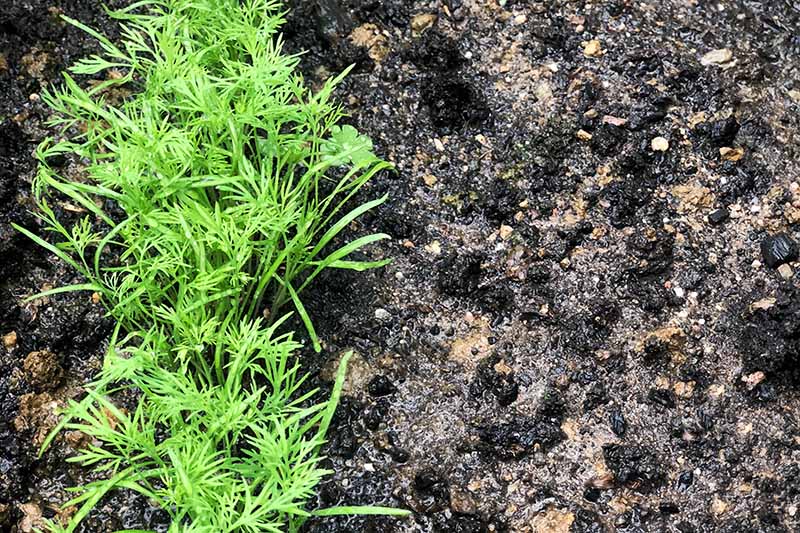
The other thing you need to know before you plant this herb in your garden is that although it is an annual, it has a tendency to self-sow.
When seeds from mature plants fall on your garden soil, they are happy to grow into full sized plants next year without any help from you.
So if you plant this herb once, you may not need to plant it again.
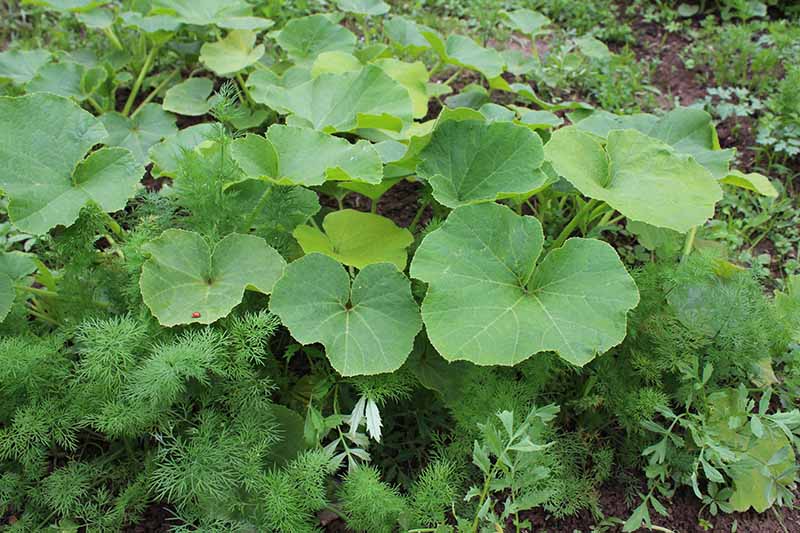
This is even the case in my garden in northeast Utah where plants have to contend with extremely dry conditions, harsh wind, sub-zero winter temperatures, and short summers.
Since starting seeds a few years ago, I find volunteer dill plants scattered throughout my garden every year.
I consider this a boon instead of a problem since dill is one of my favorite herbs, and it seems I never have too much.
However, if free dill in future growing seasons doesn’t sound like something you want, I’ll make some recommendations on how to prevent these weedy volunteers a little later.
From Seed
The best way to plant this herb in your garden is to grow it from seed instead of setting out transplants.
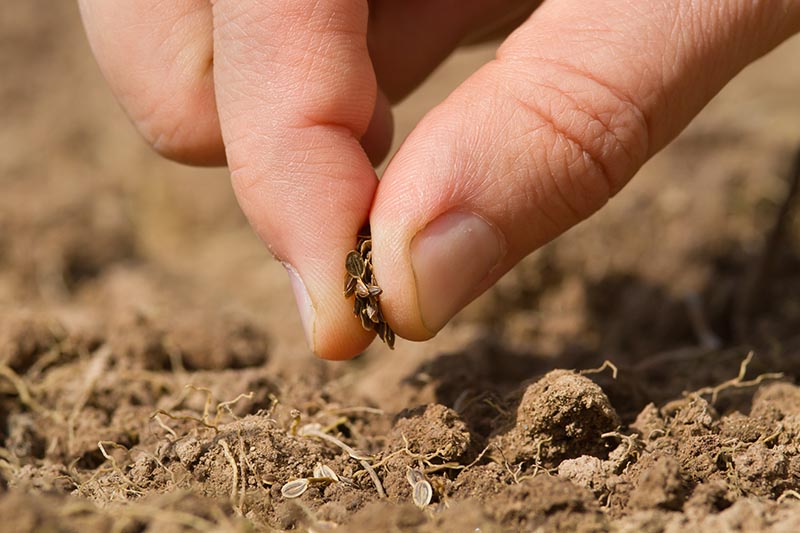
This is because it has a long, sensitive taproot, joining a few other garden staples, like carrots and beets, that do not appreciate transplanting.
When dill is transplanted, it tends to immediately bolt – that is, if it doesn’t simply die. So do yourself a favor and go the best route by planting this herb from seed.
When you’re ready to sow your seeds, here’s how to do it:
- Plan to sow your seeds two to three weeks before your last spring frost.
- Prepare your soil by mixing in some compost, even out the surface of the soil, and then wet it down lightly.
- Press the seeds gently into the surface of the soil. Dill seeds need light to germinate, so they should either remain bare on the surface or cover very lightly with soil, about 1/8 of an inch.
- Plant a group of three seeds every four to six inches, in rows spaced 12 inches apart.
- Provide a gentle daily watering until seedlings emerge.

Just so you know, germination can take 10 to 14 days, or sometimes longer.
When the seedlings are a few inches tall, thin out the weaker ones so that there is one plant spaced every four inches.
And don’t forget to eat the thinned seedlings!
If you live in a dry climate like I do, growing your dill plants four inches apart will work great.
However, if you live in a more humid climate, leave six inches between each plant instead.
Providing plants with a little extra room will allow for better air circulation and help prevent disease, while still allowing you to maximize your harvest.
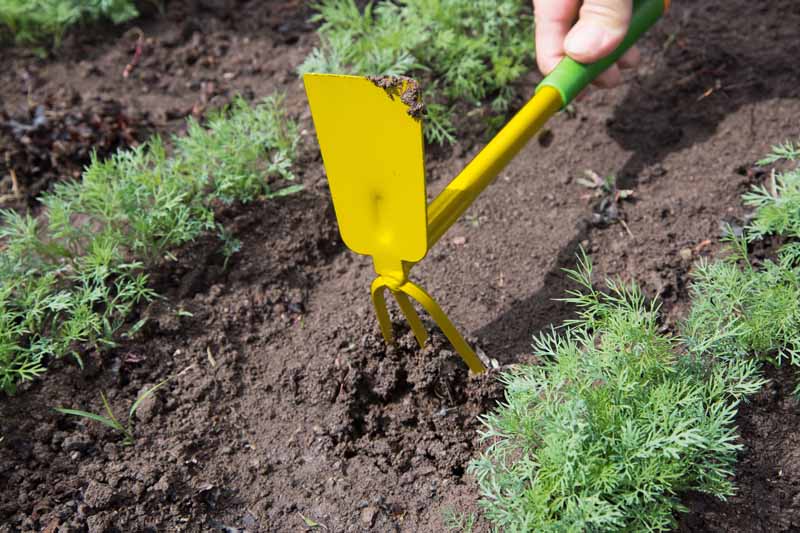
And despite its reputation, this herb is not an aggressive grower, so make sure to remove any weeds around your young seedlings.
How to Grow Dill Weed
Dill is pretty low maintenance as far as herbs go. It gives and gives, and it really doesn’t ask for too much in return.
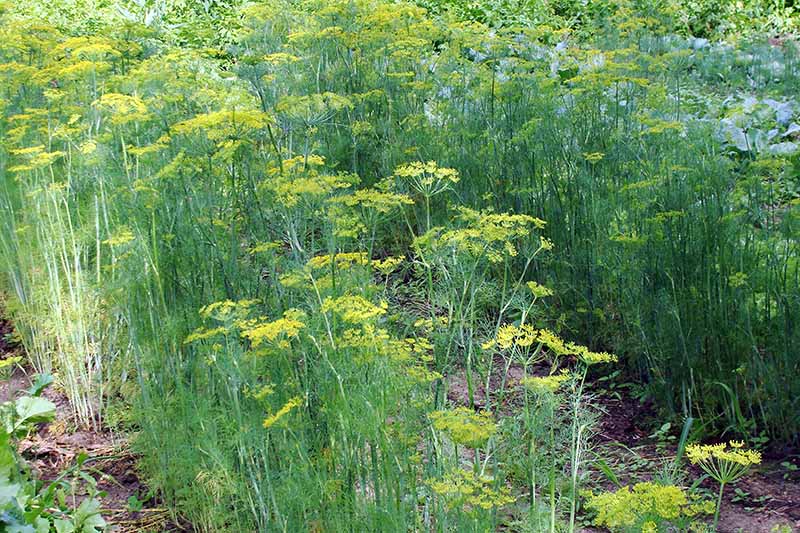
But if you want it to give you all it’s got, do it a favor and provide it with the best possible growing conditions.
Sun
This herb grows best in a full sun location, with six to eight hours of sunlight per day.
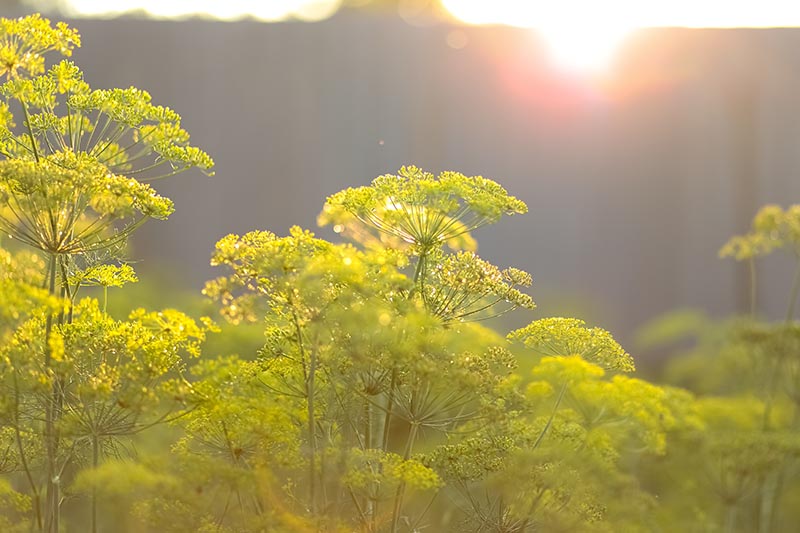
You can still grow dill if you’re working with part shade, but its stems will not be as sturdy, so you may need to stake it.
Another situation where staking can be helpful is if your area is prone to high winds.
In my garden, we frequently receive strong afternoon winds, and so far my dill plants – grown in full sun – have managed to remain upright without staking.
I think since they are trained from a young age to withstand these winds, they develop stronger stems as a result.
So consider your growing conditions and decide whether staking is prudent for your situation or not.
Soil
This herb’s main requirement is well-draining soil, with a slightly acidic pH of 5.6 to 6.5.
If you are starting with clay soil, work some compost into it, or consider growing in a raised bed or in containers.
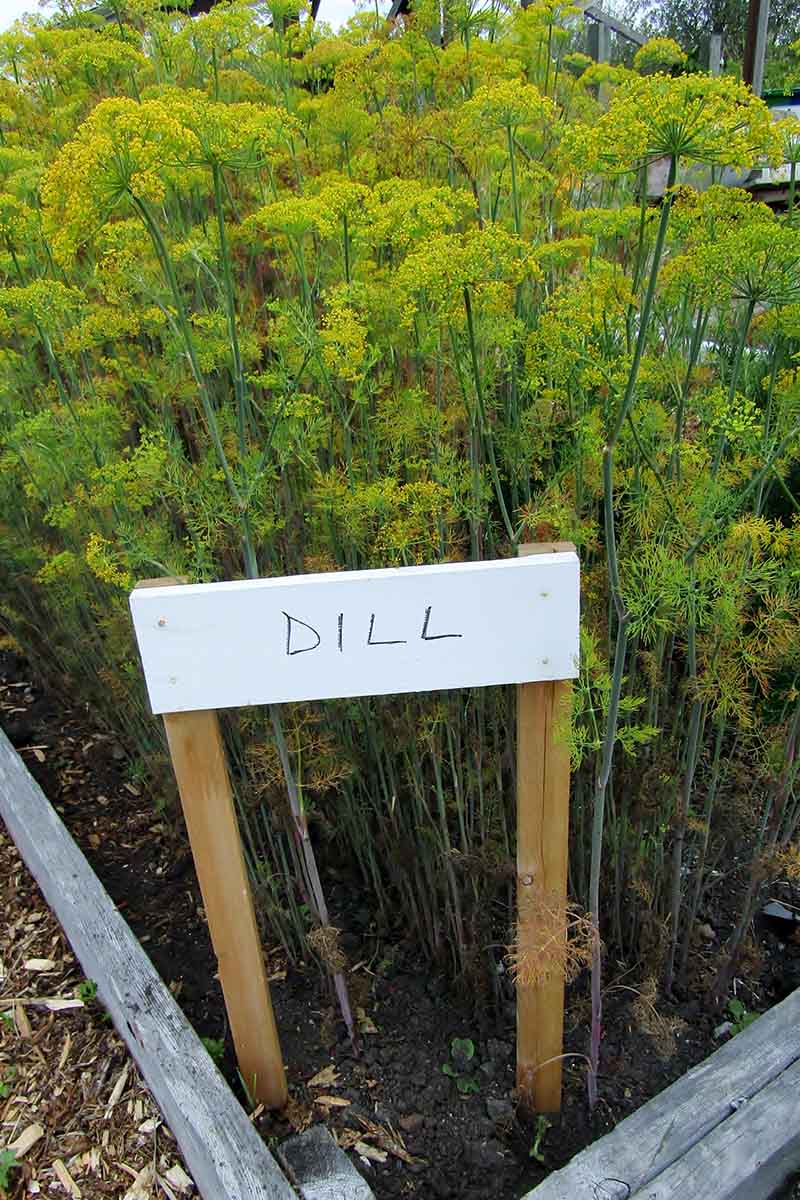
Apart from requiring good drainage, dill is not very picky and can grow in poor soils, which is why it has such an easy time establishing itself without help from the gardener.
If you aren’t sure what type of soil you have, consider conducting a soil test through your local extension office to find out.
Water
Once established, this herb is fairly drought tolerant. Just make sure established plants receive about an inch of water per week.
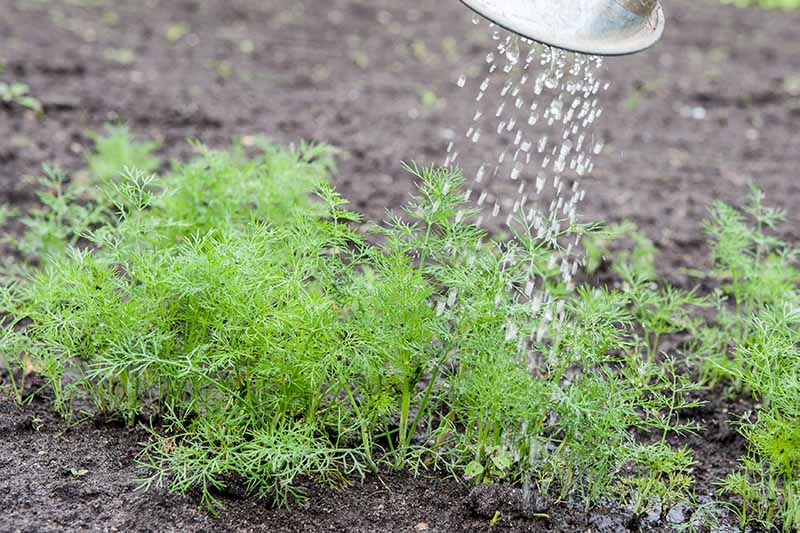
And when watering, try to water at the soil level with a watering wand or drip irrigation lines.
Overhead watering, such as with sprinklers, can put your herb at a higher risk of infection since many fungal diseases thrive in wet conditions.
Fertilizer
As mentioned above, this herb will happily make itself at home in poor soil.
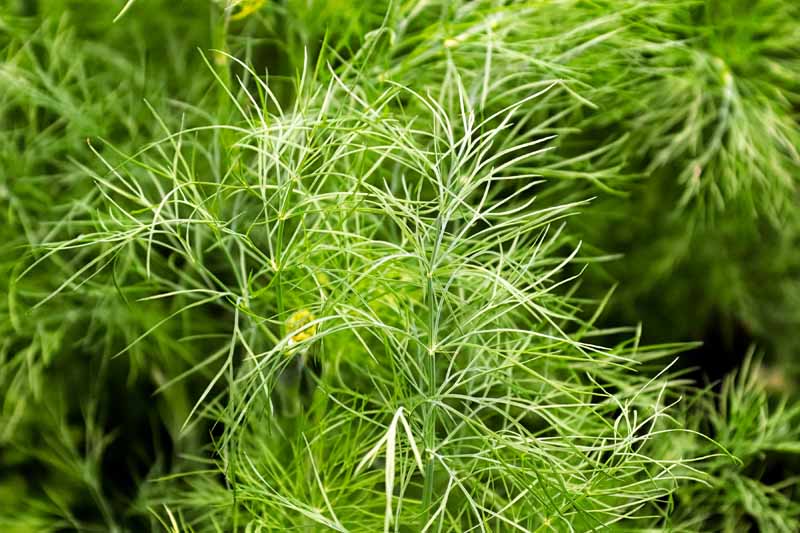
However, working an organic fertilizer such as well-composted manure or vermicompost into your soil will give you greater yields of both foliage and seeds – as well as more fragrant, tastier dill, thanks to an increase in essential oil content.
In my garden, I work well-composted sheep manure into my rows before sowing seeds. If you have a supply of comfrey in your garden, you can also fertilize with comfrey tea.
If neither of those options are available to you, you can feed your crop lightly with an all-purpose organic fertilizer.
Dr. Earth Home Grown Organic and Natural Tomato Vegetable and Herb Fertilizer
I recommend Dr. Earth Home Grown Organic and Natural Tomato, Vegetable and Herb Fertilizer, available at Nature Hills Nursery.
Growing Tips
This herb is pretty easy to grow – any plant that can self-seed so easily must be fairly flexible by nature.
But to help ensure a successful dill crop, here are a few more tips:
- This herb grows best when the soil temperature is about 70°F. Hot summer temps will cause it to bolt.
- Sow seeds every two to three weeks for a steady harvest.
- If growing in containers, make sure your pots are at least 12 inches deep to allow room for their taproots to develop.
- Remove flower heads as they appear, to encourage foliage production; let them grow if you want seeds.
- Avoid growing this herb next to other members of the carrot family, to discourage pests and keep disease from spreading.
- Grow with companion plants such as soybeans, garlic, leeks, and onions.
I mentioned earlier that dill self-seeds from one year to the next quite easily.
If you want to let this herb perpetuate itself, but not wherever it wants to, try sowing it into a dedicated bed and remove any seedlings that pop up elsewhere in your garden.
On the other hand, if you want to prevent self-seeding altogether, cut back flower heads while they are still yellow, to prevent mature seed from forming and potentially escaping into your garden.
These flower heads are extremely fragrant and can be used in cooking or in flower arrangements.
Dill Cultivars to Select
Remember, this plant offers a variety of different uses – you can grow it for the foliage, for its seeds, or just for garden beautification.
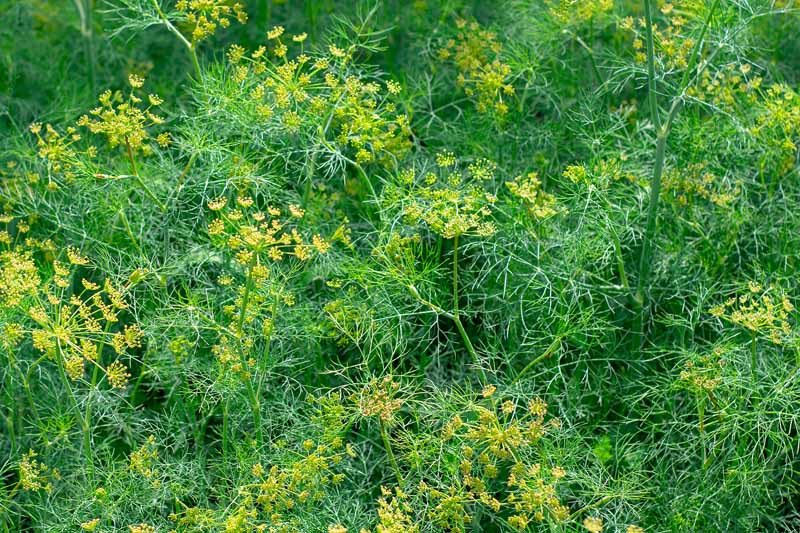
Some cultivars are best suited to particular uses.
Some are slower to bolt, meaning you get a longer harvest of leaves. Others go to seed earlier, providing you with seed heads for cucumber pickling at an earlier date. And there are height variations as well.
Think about your preferred uses for this herb and choose your cultivars accordingly. Here are a few options:
Bouquet
‘Bouquet’ flowers early and produces an abundance of seeds. This is a great choice if you want a lot of fresh cut flowers or seeds to use in the kitchen.
This cultivar can grow to 24 to 36 inches tall at maturity and has a four- to eight-inch spread.
‘Bouquet’ is ready to harvest in 40 to 60 days.
Organic ‘Bouquet’ seeds are available for purchase in an assortment of packet sizes at Eden Brothers.
Elephant
‘Elephant’ is a late-flowering variety, which means you’ll have delicious fresh dill weed throughout more of the growing season.
This cultivar reaches 30 to 48 inches in height, and has a 16- to 24-inch spread.
‘Elephant’ comes to maturity in 60 to 90 days.
‘Elephant’ seeds are available in a variety of packet sizes at Eden Brothers.
Hera
‘Hera’ is considered a bunching dill, producing lots of fragrant foliage. It is slower to bolt than many varieties.
This cultivar is also on the smaller side, reaching 18 to 24 inches in height with a spread of eight to 12 inches.
‘Hera’ reaches maturity in 40 to 60 days.
Organic ‘Hera’ seeds are available for purchase in packs of 400 seeds from Burpee.
Want More Options?
Managing Pests and Disease
Luckily for lovers of this herb, dill tends to attract more friends than foes in the garden.
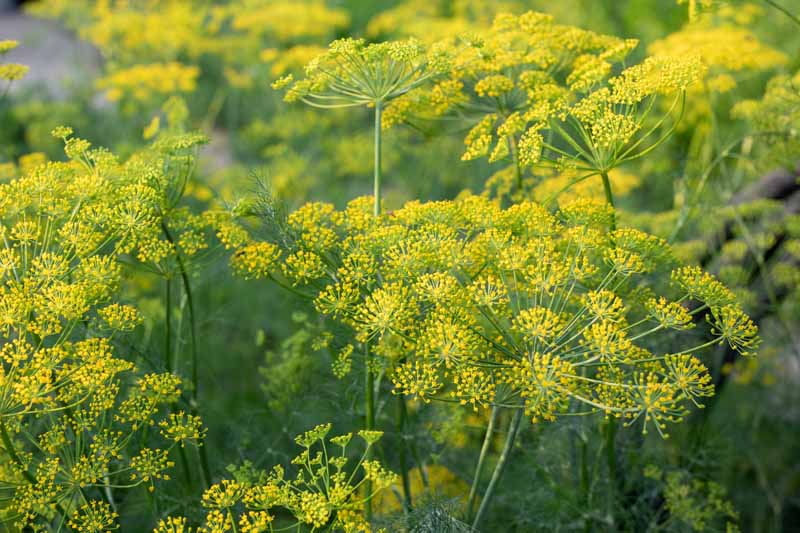
Deer don’t care for it, and most of the insects that are attracted to it are interested in feeding on the nectar from its flowers, not munching on its leaves.
However, this herb is prone to the same diseases and pests as its close relative caraway – you can learn more about these in our in-depth article on caraway diseases and pests.
There are a few insects you’ll want to look out for as well.
Insects
Generally, dill is more attractive to beneficial insects such as pollinators than problematic ones, making it a good companion to have in the garden.
Since some insects can spread disease, make sure you inspect your plants for the following unwanted pests:
Aphids
Aphids sometimes colonize this herb, and if they do, they can transmit viruses.
Your first defense in keeping an aphid problem in check is to inspect plants regularly.

If you spot aphids on the foliage, wash them off with a strong jet of water from the hose to remove them.
To prevent aphids from setting up camp in your dill patch, work on attracting beneficial insects such as parasitic wasps, green lacewings, hoverflies, and ladybugs, all of which will prey on aphids and help keep populations in check.
Luckily, this herb attracts all of these beneficial insects.
But you’ll want them around before your dill blooms, so make sure you have other pollinator-friendly plants around to provide them with food and shelter throughout the gardening season.
Another way to prevent aphid problems is to use companion plants to repel them.
There are many research studies showing that alliums such as garlic and onions are effective at repelling various types of aphids to protect a wide variety of main crops – ranging from cereal crops in China to tomato crops in Zambia.
If aphids are a concern, try growing alliums with your dill.
Black Swallowtail Caterpillars
This herb is a host plant for black swallowtail caterpillars – which turn into black swallowtail butterflies.
Although it will nibble on your dill, many gardeners do not consider this caterpillar to be a pest.
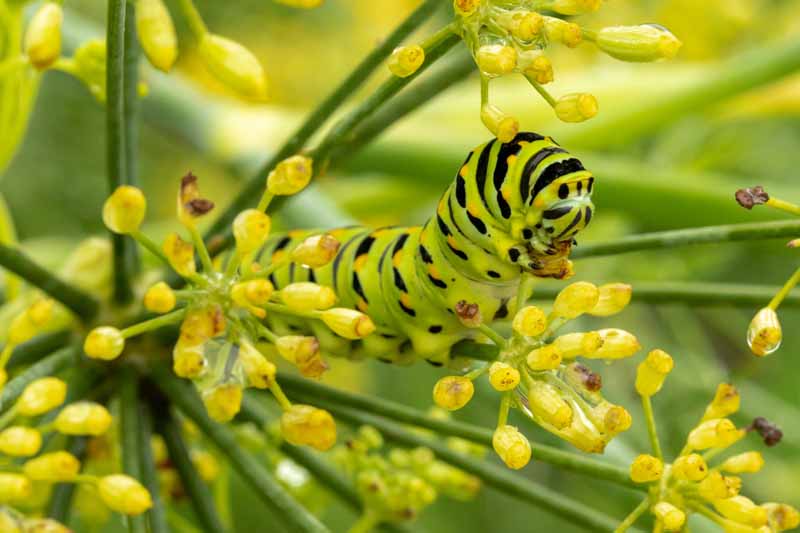
The caterpillar form has a few different stages – so before you squish any caterpillars you find on this plant, make sure you identify it properly.
Black swallowtails are also attracted to other members of the carrot family. The adult butterflies lay eggs on these plants, and when the eggs hatch, the caterpillars use them as food.
Most gardeners are willing to sacrifice a little dill to these guys if they show up, in exchange for the chance to view them flitting around in their beautiful mature form.
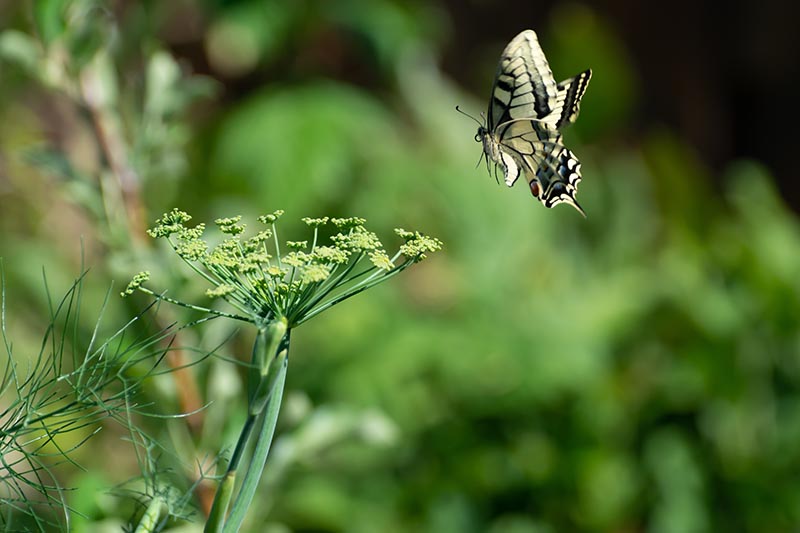
However, if needed, the caterpillars can be relocated. A stand of Queen Anne’s lace, another member of the carrot family, would be a good alternative, providing them appropriate food and shelter.
Root-Knot Nematodes
Root-knot nematodes – not to be confused with beneficial nematodes – also affect carrots, kale, and many other broadleaf plants you may be growing in your garden.
Above-ground signs of these pests can be difficult to recognize – plants may appear stunted, or may wilt for no apparent reason.
Pulling up the plant will reveal knots on the roots, thus the name of this pest.
To manage an existing problem, try solarizing your soil to kill the pests, or giving the problem area a break from veggie growing and instead grow a cover crop of marigolds in the infested area.
Disease
In keeping with its easygoing nature, this herb isn’t particularly prone to disease.
Most diseases can be prevented by making sure you don’t grow these plants in overly wet or humid conditions. Don’t overwater, provide well-drained soil, and allow adequate spacing between plants to encourage airflow.
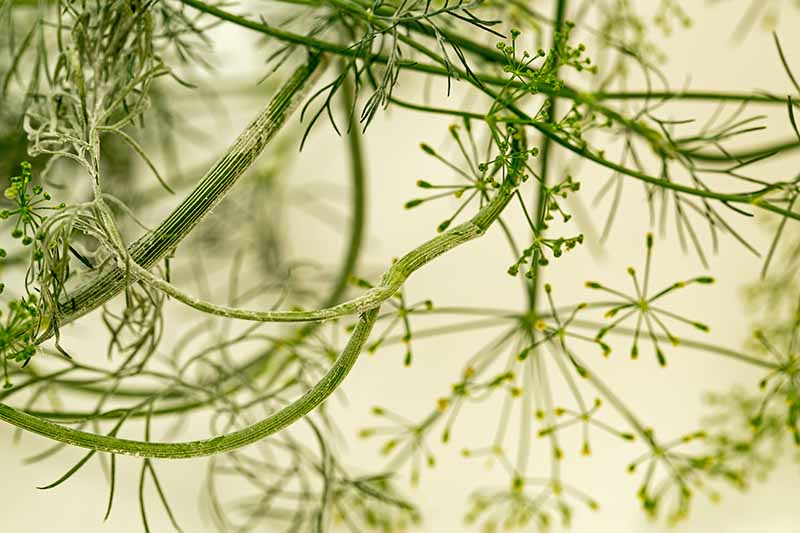
Generally, gardeners in humid climates are more likely to have problems with disease than those in arid climates.
Here are some of the diseases that can affect this plant:
- Carrot motley dwarf
- Carrot redleaf virus
- Carrot mottle virus
- Cercospora leaf blight
- Damping off
- Downy mildew
- Powdery mildew
- Root rot
To learn more about managing diseases in dill plants, make sure to consult our article on this topic – coming soon!
Harvesting Dill
Hopefully, your dill-growing adventure will take you straight to harvest time with no pest or disease issues. This is usually the case.
When your plants reach maturity, you will have the choice of harvesting either the foliage or the seeds from this aromatic plant – or both!
Dill Weed
Your dill weed harvest can begin as soon as your seedlings are a few inches tall.
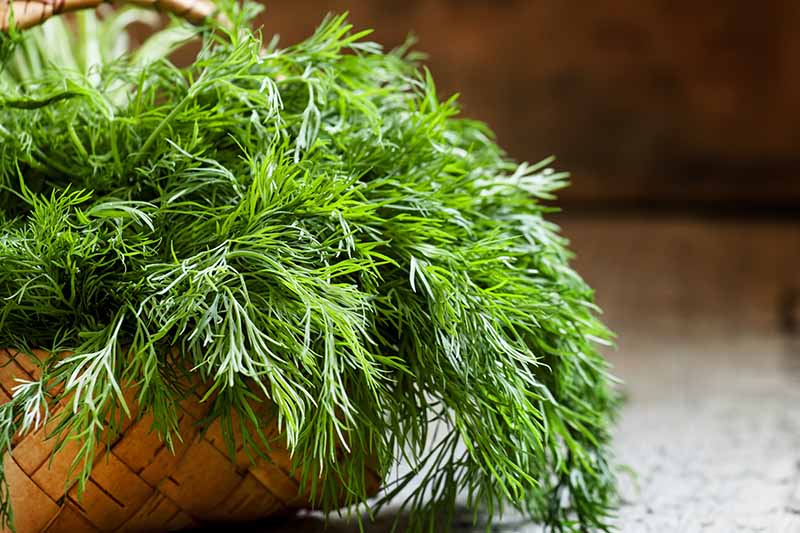
Harvesting leaves will encourage the plants to grow bushier and will help to delay flowering – this is important if you’re more interested in leaves than seeds.
Young leaves contain the most aromatic oils and are therefore the tastiest. So don’t wait for them to get bigger, go ahead and harvest the leaves regularly as it grows.
To harvest the leaves, simply pinch the stems off with your fingers – or use a pair of garden scissors.
Just make sure not to defoliate the plant – take no more than a quarter to a third of the leaves from each plant at harvest time.
This herb needs to keep some of its leaves so that it will be able to photosynthesize and continue to grow.
And keep in mind that leaves taste best when they are freshly picked.
So, during the growing season, harvest your herb just before you’re going to use it rather than picking lots at once and storing it in the fridge.
Another good time to harvest is right after flower buds form – that’s when new leaves will be the most aromatic.
At this point you can also cut the flower heads back to encourage your plant to keep producing foliage.
Or, you can let your plant go to seed, in which case it will direct its energy away from foliage production to seed production.
Dill Seeds
If you want to expand your homegrown spice collection, planting dill is an easy way to get started.
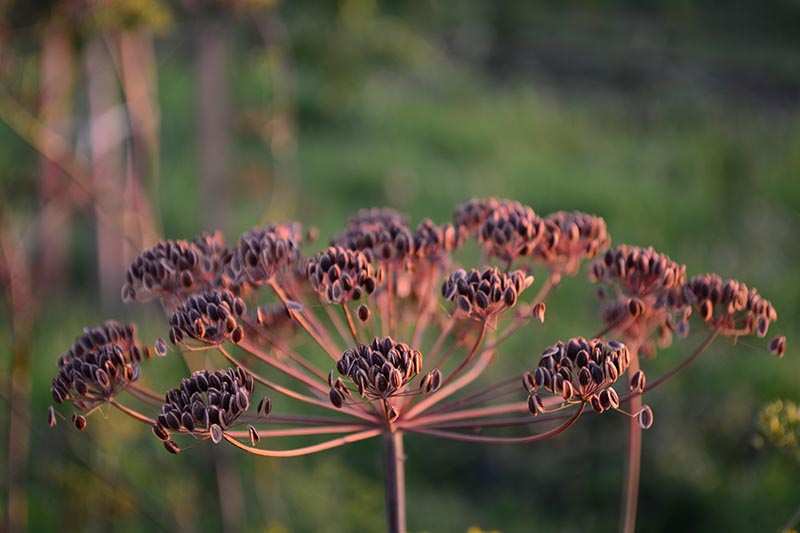
Let your plants flower and go to seed, but keep your eye on the flower heads as the seeds develop – when they turn tan colored, it’s time for action.
Cut off the umbel and place it in a paper bag.
As they dry, the seed heads will shatter and drop their seeds. By collecting them in a paper bag, you can maximize the number of seeds collected. If you allow them to dry on the plant, the seeds will drop off and fall onto your garden soil.
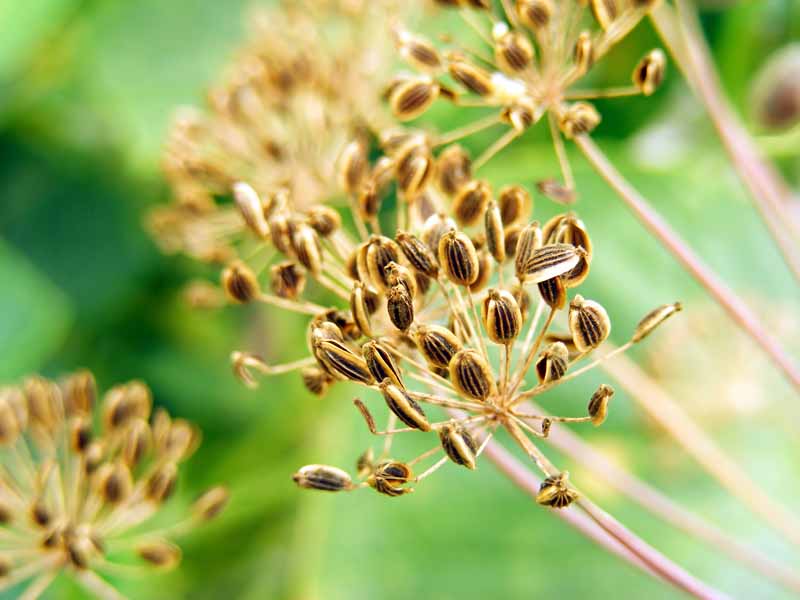
Set the paper bag aside in a warm, well-ventilated spot to let the seed head continue drying out.
Alternatively, you can also spread seed heads on a window screen to let them finish drying.
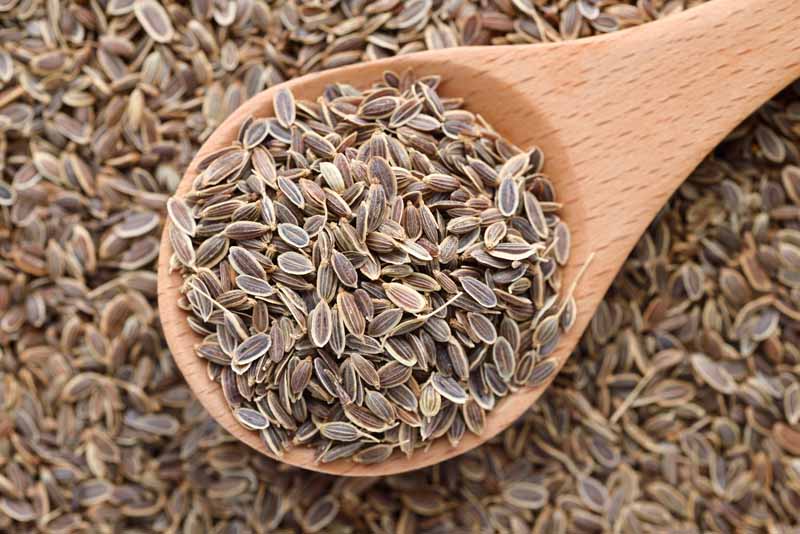
To test if your seeds are dry, try pressing your fingernail into a few of them. If the seeds bend, they are not ready yet. If they break or shatter, that is a sign that they are nice and dry.
When seeds are thoroughly dry, store them in a small spice jar and place it – with pride – on your spice rack.
And you may want to package some to add to your seed collection for sowing next year too!
Preserving
Don’t wash the herbs until you are ready to use them.

You can store fresh leaves in the fridge. Place them in a plastic bag at 32 to 41°F and you can expect your harvest to keep for one to three weeks.
Like basil, dill is at its best when fresh. However, if you want to preserve some for later, drying and freezing are great ways to create a stash for yourself for the cold months when your garden is at rest.
My preferred way to preserve this herb is to mince it, place it in a small ramekin, cover with oil, put the lid on the ramekin, and then store it in the freezer.
I find that dill preserved in this way is nearly as good as when it is enjoyed fresh from the garden – and what a nice surprise it makes when I’m digging through the freezer looking for meal ideas. It can be used in a similar way to pesto, if you want to add some minced garlic and chopped toasted nuts.
You can read more about freezing fresh herbs here.
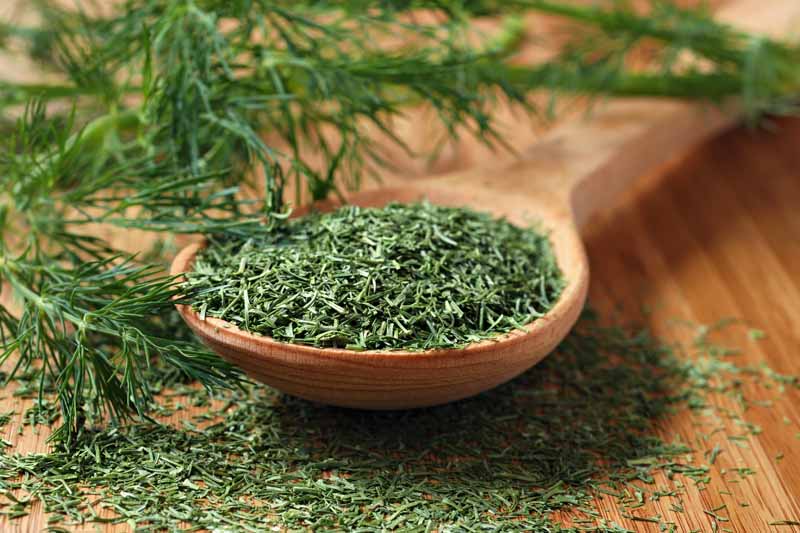
To dehydrate this herb, wash it first , and use a paper towel to pat the foliage dry. If you have a dehydrator, follow the manufacturer’s instructions for drying herbs.
You can also dry this herb at room temperature or in the oven. Store the dried herb in a cool, dry location in a jar with a lid.
Learn more about drying and storing herbs in our full guide.
Recipes and Cooking Ideas
Although pickles may be the first thing that comes to mind when you start mulling over your options, why not return to its Mediterranean origins for the most enticing cooking ideas?
Dill is one of the star ingredients in the traditional Greek cucumber and yogurt dish, tzatziki. You can find the recipe for a deliciously creamy tzatziki over at our sister site, Foodal.
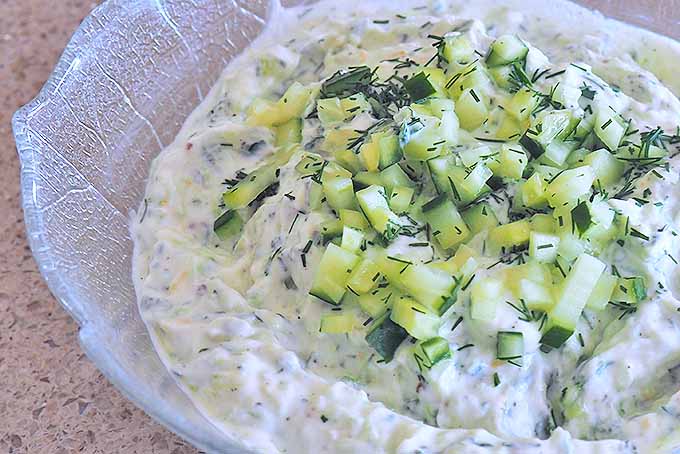
And to go with your tzatziki, how about pan-fried potatoes sprinkled with dill and minced garlic? That’s another dish that will have you feeling as though you are steps away from turquoise Mediterranean waters.
Or if your culinary daydreams take a wintery turn, you might consider sprinkling it on top of a warming bowl of borscht.
But don’t just stick to the tried and true – this herb is also a welcome ingredient with unexpected pairings.
Fresh dill brightens up the earthier ingredients in this scrumptious recipe on our sister site Foodal for brussels sprouts with bacon and fennel seed.
You can also try using this herb to make a chicken soup feel light and fresh.
And of course, I would be remiss if I didn’t bring this conversation back around to our beloved pickles.
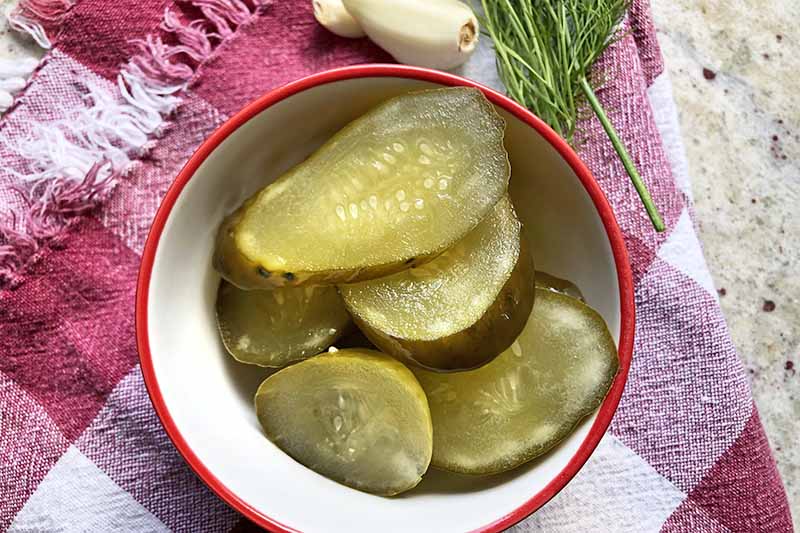
Have you ever made fermented dill pickles from scratch? If not, now’s the time to give it a try. You’ll find a recipe for lacto-fermented garlic dill pickles also on Foodal.
If that sounds great, but a bit too complicated for you at your current energy level, why not enjoy it as a simple herbal tea?

Just boil some hot water, place some fresh dill leaf or a flower head in your mug, and you’ll have your own homemade tummy-soothing infusion to enjoy.
Quick Reference Growing Guide
| Plant Type: | Annual, self-sowing | Water Needs: | Moderate |
| Native to: | Mediterranean, western Asia | Maintenance: | Low |
| Hardiness (USDA Zone): | 2-11 | Soil Type: | Average to poor |
| Season: | Summer-fall | Soil pH: | 5.6-6.5 |
| Exposure: | Full sun | Soil Drainage: | Well-draining |
| Time to Maturity: | 40-90 days | Companion Planting: | Garlic, onions, leeks, soybeans |
| Spacing: | 4-6 inches | Avoid Planting With: | Carrots, fennel, caraway, cumin |
| Planting Depth: | 1/8 inch, surface | Attracts: | Bees, parasitic wasps, green lacewings, hoverflies, ladybugs, black swallowtail butterflies |
| Height: | 8-48 inches | Family: | Apiaceae |
| Spread: | 4-24 inches | Genus: | Anethum |
| Tolerance: | Light frost | Species:: | graveolens |
| Common Pests: | Aphids, armyworms, chalcid flies, cutworms, root knot nematodes | Common Disease: | Carrot motley dwarf, carrot redleaf virus, carrot mottle virus, cercospora leaf blight, damping off, downy mildew, powdery mildew, root rot |
A Soothing Seasoning
Well, gardener, now that you have completed your education in all things dill, you could probably use a mug of that soothing and refreshing dill tea right about now. I know I’m ready for one!

Do you have any of your own dill-growing tips or recipes to share? If so, please let us know in the comments below!
And for more information about growing your own herbs and spices, check out some of dill’s fragrant relatives next:
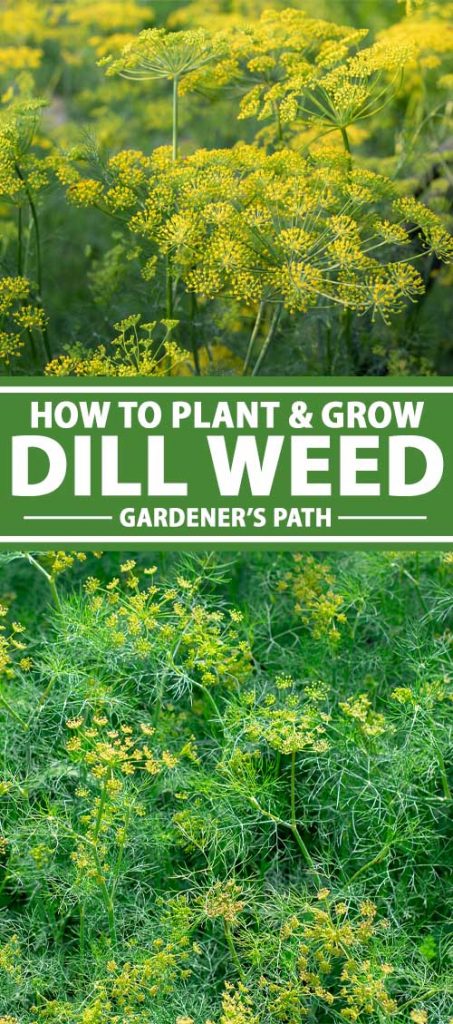
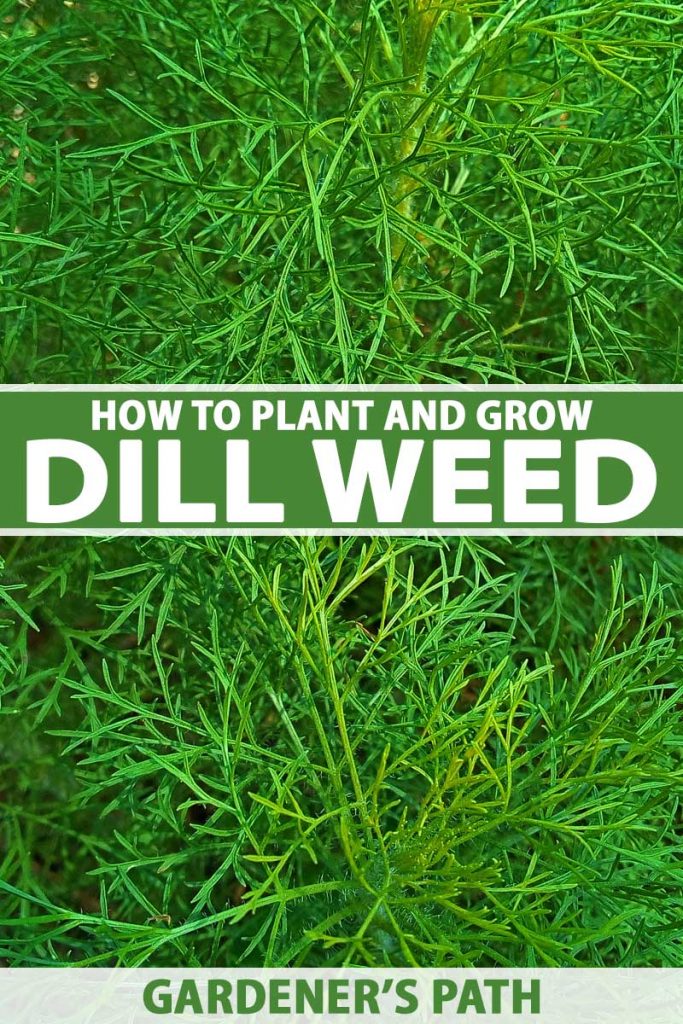
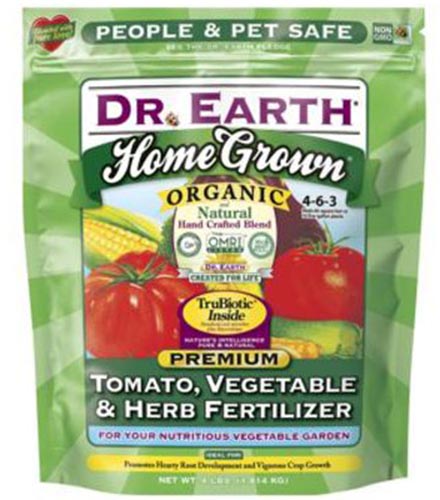
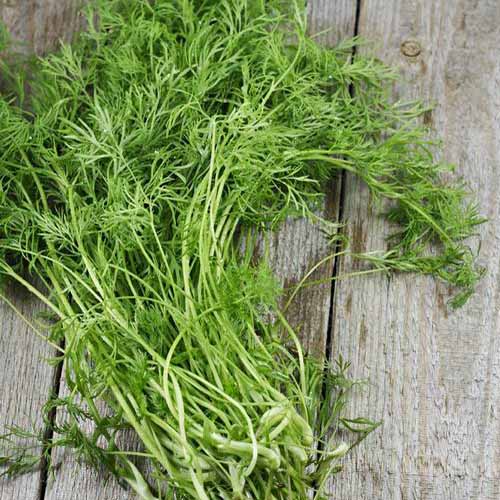

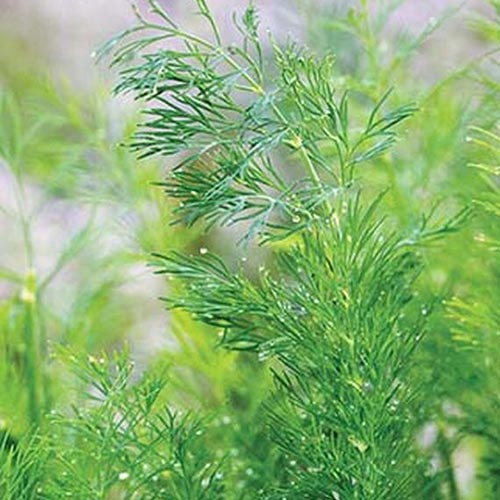
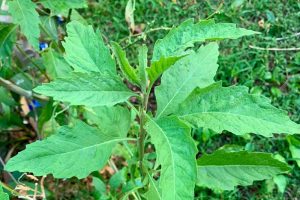
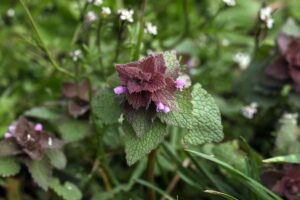
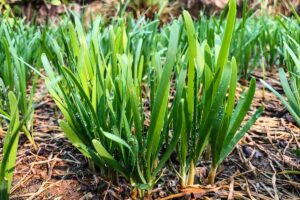
My research led me to your site. I recently bought 2 young dill plants and planted them in an Earth Box next to basil.
The information was enlightening and will be put to good use. Thank you.
Hi Jane!
Thanks so much for letting us know you enjoyed the article!
Enjoy that dill – and your basil too.
Happy gardening!
So excited for my new dill plants!
Congrats on your dill, Pam! Happy gardening to you – and enjoy!!
One of the most comprehensive discussions of dill that I’ve ever read. Some very good advice and information on my volunteer friends that return every spring. One of our favorite recipes is dill rice. We use a rice cooker and japanese short grained rice, but longer grain would probably work better. Simply put in the rice and water as normal, then as much dill as you like and we like at least a 1 TBL fresh dill per cup of dry rice, add garlic powder to your taste, put in 1 teaspoon of olive oil per cup of rice, and… Read more »
Hi Mike,
Thanks for your kind words, I’m glad you enjoyed the article. And thank you for sharing your delicious recipe idea! My own little dill volunteers are going to be ready to start harvesting soon, and I’ll be trying your dill rice recipe, with the addition of a squirt or two of fresh lemon juice. Thanks for taking the time to leave your comment!
When is the best time to grow dill and how should I plant dill for best results?
I would like to know because I doing some stuff with growing dill for science research.
Hi there,
Dill will grow best when planted in spring or fall. As to how to plant this herb for the best results, for a condensed version, see the section of the article titled “Growing Tips” above. For more detail, I suggest you start at the section titled “How to Grow.” I hope this helps!
Thanks that helps a lot
How do you think I could grow dill in a classroom?
Hello & thanks for sharing your studies & knowledge I am excited to to plant my first dill seeds now that our late winter here in Pacific Northwest hopefully has passed your read was very concise and informative Ian looking forward to reading more of your writing thanks again
Hi Tommy,
Thanks so much for the kind comment! I’m so glad you found this article helpful.
Best of luck with your dill crop this year and enjoy!
Can dill be grown in Florida?
Yes, it certainly can, Robbie!